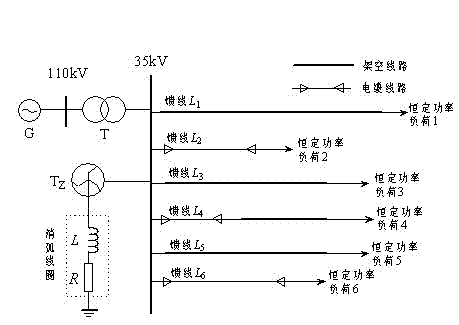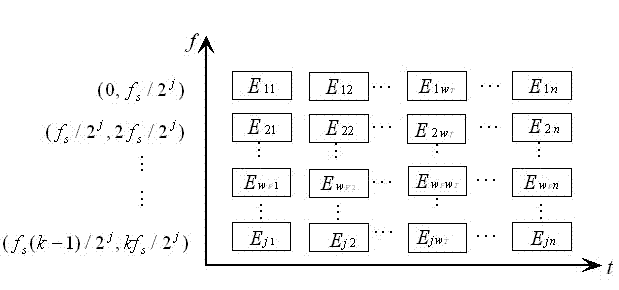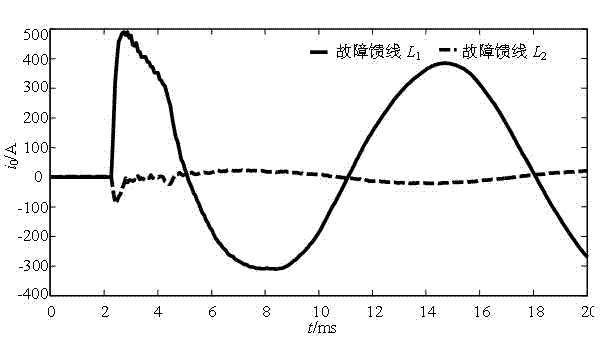Power distribution network fault circuit selection method based on transient zero-sequence current time-frequency characteristic vectors
A technology of distribution network faults and time-frequency characteristics, applied in the fault location and other directions, can solve the problems of complex fault boundaries, randomness, and decreased sensitivity of high-frequency transient line selection methods.
- Summary
- Abstract
- Description
- Claims
- Application Information
AI Technical Summary
Problems solved by technology
Method used
Image
Examples
Embodiment 1
[0036] Example 1: The single-phase ground fault simulation model of 110kV / 35kV distribution network is as follows figure 1 As shown, it has 6 feeders, and the neutral point of the Z-shaped transformer is grounded through the series resistance of the arc suppression coil. overhead feeder L 1 =15km, L 3 =18km, L 5 =30km, wire-cable hybrid feeder L 4 =17km, the overhead feeder is 12km, the cable is 5km, and the cable feeder is L 2 =6km, L 6 =8km. Among them, the overhead feeder is JS1 pole type, LGJ-70 type conductor, the span is 80m, and the cable feeder is YJV23-35 / 95 type cable. G in the power grid is an infinite power supply; T is the main transformer with a transformation ratio of 110 kV / 35kV, and the connection group is Y N / d11;T Z Is a zigzag transformer; L is the arc suppression coil; R is the damping resistance of the arc suppression coil. The feeder adopts three types of lines: overhead line, overhead line-cable hybrid line and cable line. The load uses ...
Embodiment 2
[0044] Embodiment 2: Using the model in Embodiment 1, the distance feeder L 2 An AG single-phase ground fault occurs 3 kilometers from the beginning, the ground resistance is 50Ω, the initial phase angle of the fault is 90°, and the sampling frequency is 10kHz. fault feeder L 2 and sound feeder L 4 The zero-sequence current waveform of Figure 4 shown.
[0045] Using the same method as in Example 1, select the transient zero-sequence current data 5 ms after the fault and use db10 to perform three-layer wavelet packet decomposition and reconstruction to obtain the time-frequency eigenvectors of each feeder and time-frequency feature similarity matrix , forming a comprehensive correlation coefficient matrix P ij :
[0046] P ij= ; ; ;
[0047] P 1i =[0.0613 172.1959 0.3280 0.4804 10.5826 126.1762]; ;
[0048] The top three with the largest comprehensive correlation coefficients in order of size are: P 2 =172.1959, P 6 =126.1762, P 5 =10.58...
PUM
 Login to View More
Login to View More Abstract
Description
Claims
Application Information
 Login to View More
Login to View More - R&D
- Intellectual Property
- Life Sciences
- Materials
- Tech Scout
- Unparalleled Data Quality
- Higher Quality Content
- 60% Fewer Hallucinations
Browse by: Latest US Patents, China's latest patents, Technical Efficacy Thesaurus, Application Domain, Technology Topic, Popular Technical Reports.
© 2025 PatSnap. All rights reserved.Legal|Privacy policy|Modern Slavery Act Transparency Statement|Sitemap|About US| Contact US: help@patsnap.com



